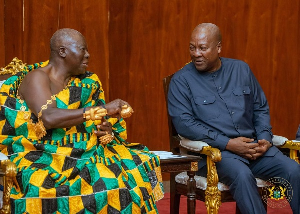Solomon Mingle, PhD, a Ghanaian scholar at University of Birmingham has developed a Leaky Wave Antenna (LWA) for remote vital signs detection using leaky wave theory (LWT).
While LWT, or LWA, is not a new concept, operating within the millimetre bandwidth in Dr. Mingle’s case, the 58 to 68 GHz range, is a difficult task when catching vital signs from a remote location.
But Dr. Mingle did it, using mere copper wires, High Impedance Surfaces (HIS) and Partially Reflective Surfaces(PRS).
In his PhD thesis successfully defended via viva voce, and journal articles based on his thesis, Dr Mingle demonstrated that it is possible to tune the HIS and PRS within the narrow millimetre wave band of 58-68 GHz.
We, Isaac Ato Mensah and Augustine Williams-Mensah, the discussants herein, from writersghana.com, in our quest to promote scholarship attempted this dialogue/reflective essay approach via social media in audio format in a bid to review/critique aspects of Dr Mingle's doctorate degree work for a wider audience. It is also our desire to showcase Dr Solomon Mingle, born in Ghana with the Osu name Adotey, as a worthy example of Ghanaian scholarship.
Below is an edited transcript of our dialogue on one of his unpublished papers titled "DESIGN AND ANALYSIS OF PARTIALLY REFLECTIVE SURFACES AND HIGH IMPEDANCE SURFACES PERIODIC STRUCTURES FOR QUANTUM LEAKY WAVE ANTENNAS AT MILLIMETRE-WAVE FREQUENCIES".
Isaac Ato Mensah [IAM]:
it is instructive that the realm of science has always made room for replication.
Indeed to see God, you have to look to nature.
By looking closely at how God created His creation, we can find solutions to life's problems.
Augustine Williams-Mensah [AW-M]: Excellent. Hence we human beings have observed that some animals have antennae or antennas. And these antennae are used to detect signals.
IAM: All right. So within this context, Dr Mingle's main goal is mimicking the antenna technology in nature to detect vibrational frequencies. But in this case because it's millimetre wave frequencies, and he's applying this technology using leaky wave antennas remotely it is very interesting. What do you think about the technology so far?
AW-M: What I've been reading about Dr Mingle's work is that he realised that between high and low frequencies he needs to simulate an antennae technology for catching the signals, despite the remoteness of the object in question.
IAM: And what is the relevance of using these high impedance surfaces; is that the antenna he's creating?
AW-M: This is, I think, passing signals through the High Impedance Surfaces as well as the Partially Reflective Surfaces into the antenna device for detection.
IAM: Okay. So the signals are already there in nature.
AW-M: Yes. For example, the heartbeat of a baby buried in the rubble in Gaza.
IAM: Dr Mingle also mentioned liquid crystals.
AW-M: Yes, they can also be used to detect signals.
IAM: Okay. So now let's take the practical significance of what to do. When it comes to short waves and millimetre bandwidths, why did Solomon Mingle have to simulate natural frequencies?
AW-M: These waves move in millimetres so they are very detailed. Now you want to have a smooth line. You have a smooth transmission of signals when you try to simulate these things and detection of the waves is easier.
IAM: Yes and it is also relevant because when the signals are remote, the sounds may be muted.
AW-M: I'm noticing that by creating these simulated processes Dr Mingle is able to smooth it out and have a constant speed. It means something is happening at a consistent frequency.
IAM: Much like the way we do Scatter diagrams to find the mean or average line in order to draw conclusions about the data. Now let us come to the methodology.
AW-M: Dr Mingle's work makes use of High Impedance Surfaces to create a millimetre wave antenna. In other words our bodies can detect both High Impedance Surfaces and Partially Reflective Surfaces in the millimetre wave antenna which helps detect our vital signs.
Dr Mingle tried to tune into High Impedance Surfaces and Partially Reflective Surfaces to create a millimetre wave Leaky Wave Antenna. According to him, and I quote, "this helps to have precise beam steering within the 58 to 68 GHz frequency range".
IAM: Why did he have to simulate? He was trying to simulate between the natural frequency and a simulated wave frequency. These waves are moving in millimetres so it's like if you were to draw a graph you'll see that it has very sharp and rough edges. It's kind of a rugged surface of a mountain. So you want to have a smooth line so that you have a smooth transmission of signals. Meaning he tried to simulate his own frequency detection system which is the leaky wave antenna using dielectric technology.
AW-M: In other words this antenna smoothens out the rugged edges so that the signals can be detected easily.
IAM: Thank you.
AW-M: By passing the signals through HIS and PRS those surfaces smoothens the signals out for easy detection.
IAM: Exactly. And it's relevant also because when the signals are remote and muted, you may catch some of the signals but not catch others. By creating this process Dr Mingle is able to smoothen out the signals as Augustine said, at a constant speed. Thus, you can say that yes, something is happening for sure, at a consistent frequency. Is there anything more we can say about his methodology to give further confidence in his work?
Okay. Dr Mingle wrote: "We performed simulations using the CST [Computer Simulated Technology] Microwave Studio Simulation Software". An existing software for simulating such models so it is an existing method which has been replicated and tried and tested. Let's quote him again: "In the software the scanning range of the High Impedance Surface was achieved by varying the frequency as a parameter. To simplify the calculation of the infinite structure, periodic boundary conditions were employed allowing us to analyze the behaviour of a single unit cell".
AW-M: In other words he compares and contrasts different frequencies in other to determine the scanning range of the High Impedance Surfaces.
IAM: What would you say is Dr Mingle's thesis statement? I say:
High Impedance Surfaces and Partially Reflective Surfaces have proven effective in remotely detecting vital signs,and the materials that Dr Mingle used have been tried and tested and found suitable for creating leaky wave antennas.
AW-M: I say: Leaky Wave Antennas enable precise beam steering by adjusting to a resonant state which helps to get precise calculations and correct measurements.
Dr Mingle's work focuses on "the comprehensive design, simulation and fabrication of High Impedance Surfaces and Partially Reflective Surfaces operating at millimetre wave frequencies ranging from 58-68 GHz. The High Impedance Surface structure demonstrates an impressive phase shift capability of 390° while the Partially Reflective Surfaces achieve a notable phase of -158°". And he adds that such efficiency and effectiveness allow for a wide range of beam scanning capabilities within a ground range to minimize their shortcomings.
IAM: Thank you so much. Please visit writersghana.com for more scholarly reviews. Goodbye.
AW-M: Bye.
Augustine Williams-Mensah is an undergraduate student at the Faculty of Applied Behavioural Sciences in Education, University of Education Winneba.
Dr Solomon Mingle, originally from Ghana, is a researcher at the University of Birmingham, UK. He is a product of Accra Technical University, and Pope John Secondary School.
Isaac Ato Mensah is an independent scholar and journalist. He is the founder of writersghana.com, a research, writing and publishing house.
Opinions of Wednesday, 27 March 2024
Columnist: Isaac Ato Mensah/Augustine Williams-Mensah















